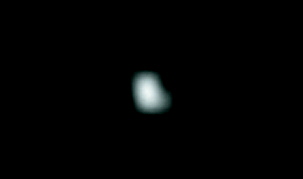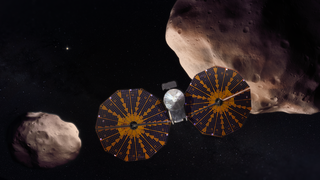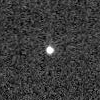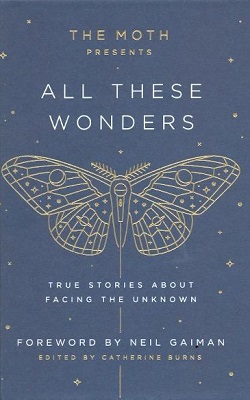
New Horizons is an interplanetary space probe launched as a part of NASA's New Frontiers program. Engineered by the Johns Hopkins University Applied Physics Laboratory (APL) and the Southwest Research Institute (SwRI), with a team led by Alan Stern, the spacecraft was launched in 2006 with the primary mission to perform a flyby study of the Pluto system in 2015, and a secondary mission to fly by and study one or more other Kuiper belt objects (KBOs) in the decade to follow, which became a mission to 486958 Arrokoth. It is the fifth space probe to achieve the escape velocity needed to leave the Solar System.

Neptune trojans are bodies that orbit the Sun near one of the stable Lagrangian points of Neptune, similar to the trojans of other planets. They therefore have approximately the same orbital period as Neptune and follow roughly the same orbital path. Thirty-one Neptune trojans are currently known, of which 27 orbit near the Sun–Neptune L4 Lagrangian point 60° ahead of Neptune and four orbit near Neptune's L5 region 60° behind Neptune. The Neptune trojans are termed 'trojans' by analogy with the Jupiter trojans.
The New Frontiers program is a series of space exploration missions being conducted by NASA with the purpose of furthering the understanding of the Solar System. The program selects medium-class missions which can provide high science returns.

132524 APL (provisional designation 2002 JF56) is a small background asteroid in the intermediate asteroid belt. It was discovered by Lincoln Near-Earth Asteroid Research in May 2002, and imaged by the New Horizons space probe on its flyby in June 2006, when it was passing through the asteroid belt. The stony S-type asteroid measures approximately 2.5 kilometers (1.6 miles) in diameter.
The Jupiter Magnetospheric Orbiter is a cancelled space probe proposed by the Japanese Aerospace Exploration Agency (JAXA), to undertake detailed in situ studies of the magnetosphere of Jupiter as a template for an astrophysical magnetised disk.

The Planetary Science Decadal Survey is a serial publication of the United States National Research Council produced for NASA and other United States Government Agencies such as the National Science Foundation. The documents identify key questions facing planetary science and outlines recommendations for space and ground-based exploration ten years into the future. Missions to gather data to answer these big questions are described and prioritized, where appropriate. Similar decadal surveys cover astronomy and astrophysics, earth science, and heliophysics.

Adriana C. Ocampo Uria is a Colombian planetary geologist and a Science Program Manager at NASA Headquarters. In 1970, Ocampo emigrated to California and completed her Master in Sciences at California State University, Northridge and finished her PhD at the Vrije Universiteit in the Netherlands. During high school and graduate studies she worked at the Jet Propulsion Laboratory, where she serves as the science coordinator for many planetary missions.

Dr. Colleen Hartman is currently the Board Director for the Space Studies Board as well as the Aeronautics and Space Engineering Board of the National Academies of Sciences, Engineering, and Medicine in Washington, D.C. She was the deputy center director for Science, Operations and Performance of NASA’s Goddard Space Flight Center and most recently, was the Director of the Science and Exploration Directorate. Previously she was acting Associate Administrator of the Science Mission Directorate (SMD), Deputy AA of SMD and presidential management intern, served as a senior policy analyst at the White House Office of Science and Technology Policy, and served as deputy division director for technology at NASA Headquarters.

Alice Bowman is the Mission Operations Manager for the New Horizons mission to Pluto. She is the first woman to fill that role at the Applied Physics Laboratory, taking on the position in 2002 specifically for the duration of the three billion-mile space journey.

Lucy is a NASA space probe on a twelve-year journey to eight different asteroids. It is slated to visit two main belt asteroids as well as six Jupiter trojans – asteroids that share Jupiter's orbit around the Sun, orbiting either ahead of or behind the planet. All target encounters will be flyby encounters. The Lucy spacecraft is the centerpiece of a US$981 million mission. It was launched on 16 October 2021.

21900 Orus is a Jupiter trojan asteroid from the Greek camp, approximately 53 kilometers in diameter, and a target of the Lucy mission to be visited in November 2028. It is among the 100 largest Jupiter trojans and has a rotation period of 13.5 hours. It was discovered on 9 November 1999, by Japanese amateur astronomer Takao Kobayashi at his private Ōizumi Observatory in Gunma Prefecture, Japan, and later named Orus after a slain Achaean warrior from the Iliad.

15094 Polymele is a primitive Jupiter trojan from the Greek camp, approximately 21 kilometers in diameter. It is a target of the Lucy mission with a close flyby planned to occur in September 2027. It was discovered on 17 November 1999, by astronomers with the Catalina Sky Survey at Mount Lemmon Observatory, Arizona, in the United States. The P-type asteroid has a rotation period of 5.9 hours and highly flattened shape. It was named after Polymele from Greek mythology, the wife of Menoetius and the mother of Patroclus. In 2022, it was reported to have a natural satellite approximately 5 kilometers in diameter.

The Moth Presents: All These Wonders. True Stories About Facing the Unknown is a 2017 collection of stories from the radio program The Moth, edited by the show's artistic director Catherine Burns on the 20th anniversary of the show's 1997 founding. The 336-page collection of 45 stories was published by Crown Archetype. The title story, "All These Wonders", is by planetary scientist Cathy Olkin.
Lisa Hardaway (1966–2017) was an American aerospace engineer and program manager for an instrument on the New Horizons spacecraft to Pluto and Beyond. Among her awards, she was named Engineer of the Year for 2015–2016 by the Colorado American Institute of Aeronautics and Astronautics.

Henry B. Throop, is an American astronomer and planetary scientist who specializes in the dynamics of rings and dust in the outer solar system. Throop is a member of the science team for NASA's New Horizons mission to Pluto and the Kuiper Belt, and has been involved with NASA missions throughout the solar system. Throop lives in Washington, DC where he runs NASA's science programs in the outer solar system. He has done extensive education and outreach around the world, having spent nearly a decade as an astronomer living in South Africa, India, and Mexico. The asteroid 193736 Henrythroop is named after him.

Jani Radebaugh is an American planetary scientist and professor of geology at Brigham Young University who specializes in field studies of planets. Radebaugh's research focuses on Saturn's moon Titan, Jupiter's moon Io, the Earth's Moon, Mars and Pluto. Radebaugh is a Science Team member of the Dragonfly mission to Titan, the IVO Io mission proposal, and the Mars Median project. She was an Associate Team Member of the Cassini-Huygens RADAR instrument from 2008 to 2017, and was a graduate student scientist for Io for the Galileo mission. She does science outreach through her work as an expert contributor to the Science/Discovery program How the Universe Works and other television and radio programs. In December 2012, Radebaugh and her colleagues on the Cassini mission announced the discovery of Vid Flumina, a liquid methane river on Saturn's moon Titan over 320 km (200 mi) long and resembling the Nile river.

Ralph is a science instrument aboard the robotic New Horizons spacecraft, which was launched in 2006. Ralph is a visible and infrared imager and spectrometer to provide maps of relevant astronomical targets based on data from that hardware. Ralph has two major subinstruments, LEISA and MVIC. MVIC stands for Multispectral Visible Imaging Camera and is a color imaging device, while LEISA originally stood for Linear Etalon Imaging Spectral Array and is an infrared imaging spectrometer for spaceflight. LEISA observes 250 discrete wavelengths of infrared light from 1.25 to 2.5 micrometers. MVIC is a pushbroom scanner type of design with seven channels, including red, blue, near-infrared (NIR), and methane.

Long Range Reconnaissance Imager (LORRI) is a telescope aboard the New Horizons spacecraft for imaging. LORRI has been used to image Jupiter, its moons, Pluto and its moons, and Arrokoth since its launch in 2006. LORRI is a reflecting telescope of Ritchey-Chrétien design, and it has a main mirror diameter of 208 mm across. LORRI has a narrow field of view, less than a third of a degree. Images are taken with a CCD capturing data with 1024 × 1024 pixels. LORRI is a telescopic panchromatic camera integrated with the New Horizons spacecraft, and it is one of seven major science instruments on the probe. LORRI does not have any moving parts and is pointed by moving the entire New Horizons spacecraft.
















